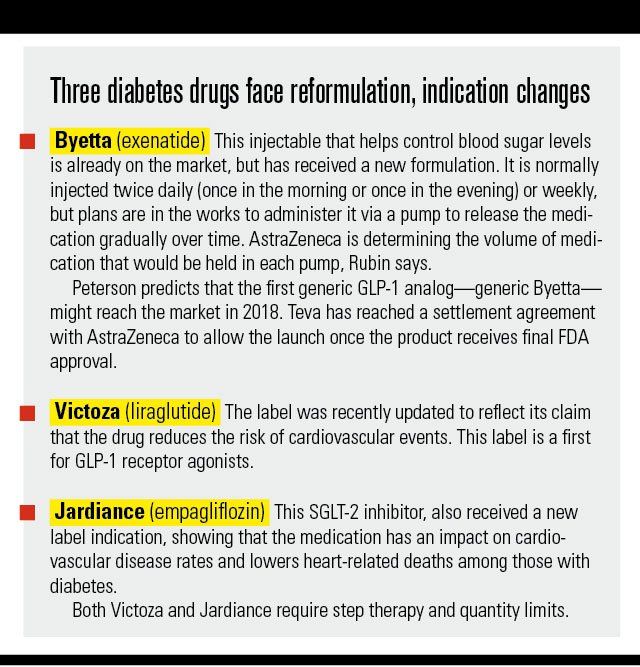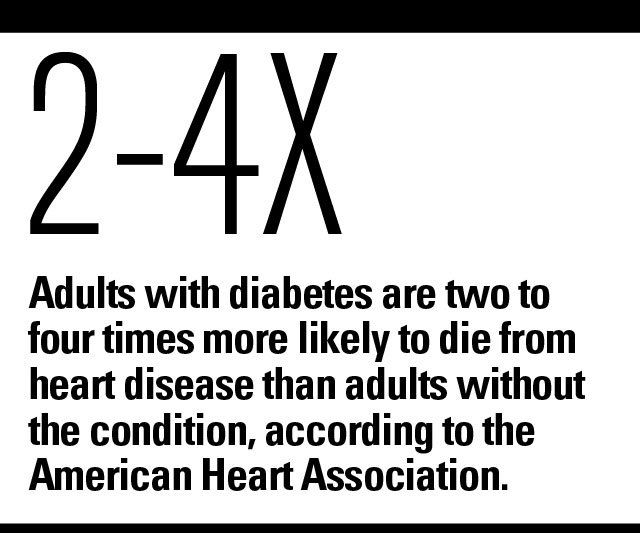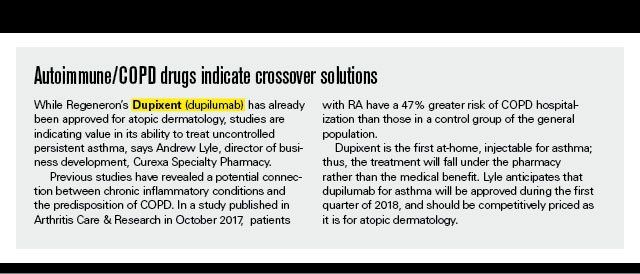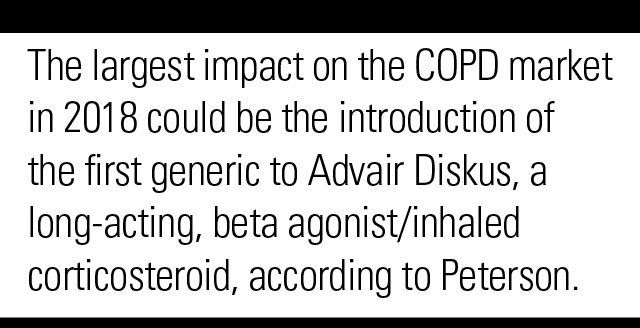Four therapeutic areas to watch in 2018
Prepare for major pipeline developments in diabetes, autoimmune disorders, oncology, and COPD.
Diabetes, autoimmune disorders, and oncology continue to be high areas of interest to managed healthcare executives in 2018. With a variety of new, high-cost drugs, chronic obstructive pulmonary disease (COPD) joins the top four therapeutic categories.
The projected specialty/biotech trend is 17.7% in 2018, down from the 18.7% in 2017, according to Segal Consulting. Although the trend is lower, specialty drugs still consumed one-third of total drug costs in 2016, with expected growth to 50% by 2020, according to Segal.
Prime Therapeutics, a pharmacy benefits manager (PBM), reports that through mid-year 2017, specialty spending on the medical and pharmacy benefits combined was about 45%.
Here are some of the latest developments in the top four therapeutic areas for 2018:
Diabetes
Merck’s follow-on insulin glargine product, Lusduna Nexvue, was granted “tentative approval” in 2017, but its market availability-probably 2018 or 2019-is contingent upon resolving ongoing patent litigation.
“Although not A-rated, or a substitute at the point of service with Lantus, an already approved insulin glargine, it is a therapeutic option,” says Christopher Peterson, director of clinical evaluation and policy for Express Scripts, a PBM.
At press time, approval of Mylan’s product, Basalog, another insulin glargine, is expected in July 2018, but like Merck’s product, it might face patent litigation before it becomes available.

Sanofi’s Admelog (insulin lispro), a follow-on protein to Eli Lilly’s Humalog, received approval in December 2017, and availability will likely occur in 2018, Peterson says.
Another class of diabetes medications to watch is the glucagon-like peptide-1 (GLP-1) receptor agonists, Peterson says. Novo Nordisk’s semaglutide injection, Ozempic, a once-weekly GLP-1, received approval in December 2017. This product joins the company’s diabetes portfolio, which currently includes the once-daily GLP-1 analog, Victoza (liraglutide). Other GLP-1 receptor agonists include AstraZeneca’s Byetta (exenatide) and Eli Lilly’s Trulicity (dulaglutide).

At press time, it is also anticipated that Merck and Pfizer will receive approval shortly for their new sodium glucose cotransporter-2 (SGLT-2) inhibitor, ertugliflozin, an oral therapy resulting in excretion of excess glucose in the urine and decreasing blood glucose levels.
“The SGLT-2 inhibitor class will continue to grow due to the positive cardiovascular outcomes data from studies with Invokana and Jardiance,” Peterson says.
Manufacturers are also combining diabetes drugs for increased effectiveness. Merck is expected to receive approval for ertugliflozin combination products shortly after press time, which will be taken with metformin and Merck’s Januvia (sitagliptin). In addition, Victoza joins a long-acting, basil insulin, such as Lantus or Levemir, as a rela tively new way to treat diabetes.
“This combination makes it work better and helps to reduce post-meal hyperglycemia and weight gain that can sometimes occur if a long-acting drug is taken by itself,” says Julie Rubin, director of clinical services for CompleteRx pharmacy consulting firm.
She says, however, that the combination of drugs might increase costs for already expensive drugs because patients are now using two drugs at the same time.
On the other hand, Patrick Gleason, senior director of outcomes for Prime Therapeutics, says combinations might increase utilization, providing more opportunity for controlling diabetes, even if the costs are higher. “The value is in preventing heart attacks, something that might take years with just glucose control,” he says.
Next: Oncology
Oncology
Oncology is a fertile therapeutic category with 15 drugs approved in 2017 by press time. Aimee Tharaldson, a senior clinical pharmacist at Express Scripts, says breakthrough cancer therapies-several of which are immunotherapies such as programmed cell death protein (PD-1) inhibitors and chimeric antigen receptor T-cell (CAR T) therapy-are going to continue to reach the market quickly based on early data.
She also says more oral drugs will gain approval; 40% of those in the pipeline are administered orally.

Because personalized medicine is making inroads into oncology, many cancer drugs will be accompanied by pharmacogenetic tests to identify appropriate candidates for therapy.
Sandy Smith, vice president, U.S. oncology research, McKesson Specialty Health, says 2017 brought better understanding of immunotherapy, and how drugs are clinically benefiting patients based on individual characteristics and biomarkers and why certain drugs succeed in one person and not another. While immunotherapy is primarily targeting oncology, she anticipates that use will expand to other disease states.
In November, the FDA introduced a comprehensive policy framework for the development and oversight of regenerative medicine products that could help spur the development of treatments involving human cells and tissues, including gene therapy.
One of the challenges, Smith says, is that often immunotherapy doesn’t immediately reduce the size of a tumor but could initially indicate pseudo progression. “Without sufficient education, patients won’t want to use immunotherapy,” Smith says. On the other hand, she is optimistic about immunotherapy’s effect on long-term survival, patient toleration, and quality of life.
Smith says these therapies could be quite expensive, especially when used in combination with other medications. But she says costs could become sustainable when genetic modifications improve and when these drugs are used only for select patients.
In August 2017, the FDA approved the first gene therapy-Kymriah (tisagenlecleucel), a CAR T therapy from Novartis for the treatment of certain pediatric and young adult patients with a form of acute lymphoblastic leukemia who have relapsed at least twice or no longer respond to standard treatments.
Although one multicenter trial indicates an overall remission rate of 83% within three months of treatment, the price tag for a one-time infusion could be out of reach at $475,000. A Risk Evaluation and Mitigation Strategy (REMS) is attached to the drug.
A second CAR T therapy, Yescarta (axicabtagene ciloleucel) from Kite/Gilead, followed on the heels of Kymriah, with approval in October 2017. It is indicated for adult patients with relapsed or refractory forms of non-Hodgkin lymphoma with a one-time infusion cost of $373,000. It also is accompanied by REMS, as well as a boxed warning.
Tharaldson anticipates that a third CAR T drug might be approved in the second half of 2018, as a second-line treatment for a form of non-Hodgkin lymphoma. Kymriah is expected to gain this expanded indication possibly in the second half of 2018.
Sanofi and Regeneron’s Cemiplimab (REGN2810), a breakthrough therapy in development for the treatment of adults with locally advanced, unresectable or metastatic cutaneous squamous cell carcinoma (CSCC), is expected to be the next PD-1 inhibitor to be approved, also in the second half of 2018. While other PD-1 inhibitors are on the market, Cemiplimab is the only one that targets CSCC.
Next: Autoimmune
Autoimmune disorders
Janssen’s Tremfya (guselkumab), a biologic in a new class of medications that inhibit interleukin-23 (IL-23), was approved in July 2017 for adults with moderate to severe plaque psoriasis.

The drug, which has a prolonged dosing interval of every eight weeks by subcutaneous injection after induction dosing, was approved based on clinical trials that demonstrated improved skin clearance compared to Humira.
Tremfya might be approved for an expanded psoriatic arthritis indication in 2018, says Tharaldson.
Other IL-23 inhibitors in the pipeline at press time include Sun Pharmaceuticals’ tildrakizumab, which is expected to be approved by March 2018, and AbbVie and Boehringer Ingelheim’s risankizumab, which might be approved in 2019.
“IL-23 inhibitors have demonstrated strong efficacy and are expected to eventually capture a significant part of the psoriasis market,” Tharaldson says.
Baricitinib is Incyte/Eli Lilly’s new Janus kinase (JAK) inhibitor. The RA-BEAM controlled trial, published in The New England Journal of Medicine in February 2017, shows that baricitinib, which requires only one dose daily, is superior to Humira in improving signs and symptoms in patients with rheumatoid arthritis (RA).
In April, the FDA sent Eli Lilly and Incyte a complete response letter for baricitinib, asking for additional clinical data to determine the most appropriate dose and more clinical data to understand the potential risk of thromboembolic events.
The companies responded that they will resubmit their application for approval by the end of January 2018 and hope to be off and running by next summer.
AbbVie also has a JAK inhibitor, upadacitinib, which may be approved for RA in 2019.
Gleason is concerned that these drugs will not result in a value payout from medical offset because patients with autoimmune diseases are plagued by several other conditions and by the drugs’ high prices.
Next: COPD
COPD
Following on the heels of three COPD medications approved in 2017 is Sunovion’s SUN-101 (glycopyrrolate nebulization solution), a long-acting, muscarinic antagonist (LAMA) that allows for rapid administration of the product. Its approval is expected shortly after press time. AstraZeneca/Pearl also are planning a new product for COPD, a twice-daily, inhaled LAMA.

While triple therapy-a combination of an inhaled corticosteroid, a LAMA, and a long-acting beta agonist-shook the market in 2017, Peterson says that the largest impact on the market in 2018 could be the introduction of the first generic to Advair Diskus, a long-acting, beta agonist/inhaled corticosteroid. Sandoz’ generic is currently under FDA review with a possible approval in mid-2018, along with Advair generics from Mylan and Hikma/Vectura headed for the second half of 2018.
At press time, AstraZeneca is awaiting approval of Daxas (roflumilast), which counteracts the effect of an enzyme that contributes to inflammation, due to its side effect profile. In November 2017, the company also received FDA approval for Fasenra (benralizumab), for severe eosinophilic asthma. It is the first respiratory biologic with an eight-week maintenance dosing schedule. Also being evaluated for COPD, benralizumab is expected to hit the market in first or second quarter 2018.
“Benralizumab, however, doesn’t have the brand recognition that dupilumab does,” Lyle says, “even though it has proved equal in efficacy in clinical trials. Both drugs represent a new method of delivery as self-injectables, placing responsibility on patients and specialty pharmacies for adherence. Now that the door is open, there are likely to be me-too drugs in this space.”
Lyle foresees that these drugs offer a value proposition and will land on formularies with prior authorization and step therapy.
This week on Tuning Into The C-Suite Briana Contreras spoke with Dr. Scott Hayworth, president and CEO of New York-based CareMount Medical. In this interview, the two discussed the importance of patients staying in contact with their doctors for the sake of reducing public health risks and to discuss ongoing care options with them.
Listen
Eric Levin talks PBMs and how Scripta is Tackling the Market's Challenges for Patients
July 22nd 2020MHE's Briana Contreras spoke with CEO of Scripta, Eric Levin. The two discussed the current state of the pharmacy benefit market and how the Scripta organization has been assisting its clients and their prescriptions prior to the COVID-19 pandemic and during.
Listen